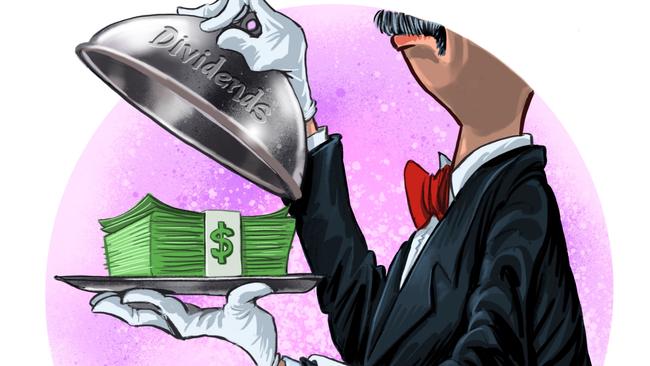How the power of share dividends can boost your investment returns
HUNDREDS of thousands of Australians have received a nice surprise as $28.5 billion has been paid out by our top 200 ASX listed companies.

Saver HQ
Don't miss out on the headlines from Saver HQ. Followed categories will be added to My News.
HUNDREDS of thousands of Australians have received a nice financial surprise over the last three weeks as $28.5 billion worth of dividends has been paid by our top 200 stock exchange listed companies.
Around 90 per cent of the ASX 200 companies elected to pay a dividend out of profits from the last financial year. It is not only an enormous amount of money but also a critical performance buffer for your listed investments.
The power of dividends to supercharge the performance of listed shares (or cushion them in a downturn) is always underestimated as we tend to focus only on share price movement. We often forget the dividend return.
Since January 2004, the indexed share price return of stocks in the All Ordinaries Index is around 90 per cent. But the total return (share price movement plus dividends) is 255 per cent … that’s the power of dividends.
Studies in the US show that over a one-year period, 80 per cent of share’s return comes from fluctuations in share price. But over a five-year investment horizon, 80 per cent of a share’s return comes from dividend yield and dividend growth.
With many top 200 companies paying a dividend yield of 5-7 per cent, add the impact of franking credits and that return can jump to an impressive 9 per cent.
Fully franked dividends are those from companies which that have paid the full rate of company tax on their profits. As a result, the share of profits they pay shareholders as a dividend comes with a tax credit equal to the amount of company tax which has been paid to avoid double taxation.
MORE: BORROWERS BRUSH BANKS AND SAVE
MORE: WHY AUSSIES ARE LOSING $600 A YEAR

For example, the major banks pay the full 30 per cent company tax on profits so their shareholders receive a dividend with a 30 cents in the dollar tax credit. If a shareholder’s marginal tax rate is less than 30 per cent, then that dividend is tax-free.
The four major banks currently all have fully franked dividend yields over 6 per cent, and we bet they don’t offer that sort of tax advantaged income return through any of their banking products to customers.
They are attractive returns and a powerful boost to investor returns but it must be acknowledged that dividend yields are a reflection of not only the share of profits a company pays out but also its share price.
As dividends are fixed as a dollar amount twice a year, the percentage dividend yield will obviously go up if the dividend payout stays the same while the share price goes down.
So an investor has to balance up the current attractive dividend yield with the prospects of the individual companies. Is a low share price because the company is in a prolonged slump and may not be able to maintain its dividend payout? Or is it a short term downturn and the company is strong enough to bounce back and maintain its dividend?
If, in consultation with your broker or financial planner, it’s the latter reason then investing in strong blue chip stocks with good dividend yields can be attractive.
Financial services giant AMP is a classic example of this. In April its share price was as high $5.47 while today it’s down around $3 because of the hammering it received from the banking royal commission and the subsequent turmoil it caused the board.
That plunge in share price has seen the AMP dividend yield rise to 6.25 per cent. A similar situation, although not to the extent, has occurred across all the major banking shares as investors nervously wait for the impact of potential regulatory changes.
Westpac has a 6.7 per cent dividend yield, NAB 7.2 per cent, CBA 6.5 per cent and ANZ 5.7 per cent … fully franked.
Can the banks bounce back with profits and dividends unharmed or will they be less profitable from any proposed changes and have to pare back dividends?
It’s all a question of balance. A good dividend yield from a company producing strong cash flows can provide not only a welcome income stream for investors but also ensure a comforting buffer to a falling share price.
The key is to be selective and look for a strong dividend yield, dividend growth and good cash flow to ensure that dividend can be maintained.
Brokers consistently have CSR, Telstra, AGL, Wesfarmers and WAM in their lists of stocks paying good dividends.
Not only do strong dividends make sense to super charge or cushion share price performance, they have become increasingly important for investors looking for income returns to pay bills.
After last week’s decision from the Reserve Bank to keep official interest rates on hold, again, many analysts are predicting the next rise in rates will not be until the middle of next year with some even saying it’s more likely in 2020.
Of course, banks have been increasing home loan interest rates out of cycle but they generally haven’t been lifting savings or term deposit rates. So a 6-7 per cent fully franked dividend looks incredibly attractive in a low interest rate, low inflation economic environment.
As we’ve said though, you need to get professional investment advice to build the right income investment portfolio for you. A mixture of dividends, income hybrids and bonds can offer good returns.
Originally published as How the power of share dividends can boost your investment returns


